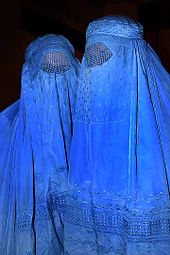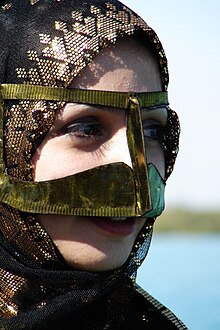Burqa
The burqa (actually Burqu, from Arabic برقع, DMG burquʿ , pluralبراقع, DMG barāqiʿ ; in Pakistan also called Barqa ) is a piece of clothing that is used to completely cover up the body. The burqa is worn by many women in Afghanistan and parts of Pakistan .
Wearing a full-body veil is related to the extent of the area defined as ʿAura (“shame”, “nakedness”). In Western countries, the term “burqa” is understood to mean any form of religiously based full veil.
Historical development
The wearing of burqas can be proven by means of illustrations from the middle of the 19th century.
Lithograph by James Rattray , 1842, Persian Kizilbasch woman in Afghanistan, behind her a woman with a burqa
Antoin Sevruguin , Two Veiled Women and a Child , late 19th century, Qajar . Brooklyn Museum
Afghanistan
The Afghan burqa (full-body veil is called the چادرى Tschaderi and the headscarf asچادر Tschadar ) consists of a large cloth with a flat cap sewn on top. Sometimes a rubber band is sewn in the forehead area. In the area of the eyes, a kind of grid made of fabric or horsehair is incorporated as a viewing window. The face is completely covered in the Afghan burqa. The fabric throw either extends down to the floor in the back and down to the hips at the front, or it is floor-length all around. The garment was created by combining a bodyveilwith aface veil.
Afghan burqas are mostly blue, but they are also made in other colors (black, green, orange or white) and some are artistically embroidered. Originally, the Afghan burqa was only worn in the city. Veiling was unusual in the village. Before the Taliban required all women to wear a burqa, blue was a rather rare color. The (originally more expensive) blue burqa developed into one of the few ways for Afghan women under the Taliban to express social status through clothing. This fashion was soon copied by less wealthy women, so that the blue color now dominates.
After the end of the Taliban government in December 2001 (see the war in Afghanistan since 2001 ), the requirement to wear a burqa was lifted. Still, only a few women dare to leave the house without a burqa. This is mostly out of concern for their personal safety and reputation. The burqa is also worn for reasons of piety and traditional tribal thinking. Sometimes it is also a means of concealing poor clothing. Compared to the chador and Çarşaf , the burqa allows much more freedom of movement because you do not have to wear pins or other fasteners and the garment does not slip.
Pakistan
Pakistani burqas leave the eyes free. It is basically a shoulder-length triangular scarf that covers the main hair, another piece of fabric is attached so that the lower half of the face is covered up to the nose. This is comparatively practical because it can be removed when necessary (e.g. when eating) without having to take off the burqa.
Oman
In Oman, the term burqa or burqa is understood to mean a face mask that differs very clearly from both the Arabic niqab (which is often incorrectly also called “burqa”) and the Afghan burqa.
In addition to bright colors (red, black, or with embroidery), the Omani burqa can also have a golden metallic shine. The different colors and shapes used to signal that they belonged to a certain tribe, today they mainly follow the fashion taste of the wearer. This face mask has its origins in the Bedouins living there, for whom it was used as an effective sunscreen in pre-Islamic times.
Ban on concealment
In recent years, some European countries in particular have banned the wearing of a face covering in public by law, either completely (e.g. Austria and France ) or partially ( e.g. in schools ; e.g. Germany ). The niqab also falls under this prohibition.
Sri Lanka introduced a ban on all types of face veils after the terrorist attack on Easter Sunday 2019 . The ban includes face covering that prevents identification.
Literary processing
After the intense discussions in the European public since 2010, authors in the field of fiction are increasingly taking up the topic. The French Lamia Berrada-Berca, in the novel Kant and the Little Red Dress , addresses emigration and the burqa: In the hope of a better life, a young woman and her husband leave their country for Paris . There she gets into a crisis: she still has to wear a burqa because her husband makes her decisions, and she is lonely. One day she discovers a beautiful red dress in a shop window. A little later, a book by Kant falls into her hands. She hides it from her husband and begins reading it secretly with her little daughter. Gradually she feels how not only the sight of the dress, but also Kant's words awaken a faint longing in her. She feels the desire to lift the veil that separates her from life and finally to feel the wide horizon of which she has only dreamed so far.
In 2007, Christina von Braun and Bettina Mathes investigated the history of the burqa and other religious clothing and other symbols in a cultural-historical presentation; they also looked at the relationship between men and women in the three monotheistic religions of Islam, Christianity, and Judaism and saw current issues Fundamentalisms in all faiths.
See also
- Veil , there also specifically the section "Islam"
- Headscarf , there also specifically the section "Islam"
- Abaya
- Burkini
- Çarşaf
- Jilbab
- Hijabista
- Headscarf dispute
- Niqab
- Parda
- Pardösü
- Shayla
- Chador
- Ban on concealment
- World Hijab Day
Web links
- Burqa Debate: What We See When We Don't See . Claudia Schmölders in conversation with Christiane Florin . Deutschlandfunk , day by day series , August 16, 2016
Remarks
- ↑ The Burqa - aesthetic protection from sun, sand and wind. Retrieved December 28, 2017 .
- ↑ Integration Act in force: “Burqa ban” applies from October 1st. In: The press . June 9, 2017. Retrieved August 8, 2018 .
- ↑ Saxony-Anhalt wants to ban burqa in schools. In: Der Spiegel . November 14, 2017, accessed August 8, 2018 .
- ↑ Augsburger Allgemeine: Sri Lanka issues a ban on veiling after attacks. Retrieved May 9, 2019 .
- ↑ Kant et la petite robe rouge. Ciboure 2011. Translated by Hanna Klimesch. Pendo Verlag , Zurich 2017
- ^ Von Braun with Bettina Mathes: Veiled Reality. Woman, Islam and the West. Structure, Berlin 2007. Quite controversial reviews from Perlentaucher




